Psychology Case Conceptualisation: Ali's Counselling Session Analysis
VerifiedAdded on 2022/08/17
|12
|3754
|18
Case Study
AI Summary
This case study presents a detailed analysis of a counselling session with a client named Ali, who is suffering from significant stress, anxiety, and symptoms of post-traumatic stress disorder (PTSD) stemming from a traumatic sexual experience. The analysis utilizes a psychodynamic framework, exploring the client's unconscious drives, repressed thoughts, and defense mechanisms. The study examines the client's history, including relationship issues, substance abuse, and sleep disturbances, and applies Erik Erikson's stages of psychosocial development to understand the client's identity confusion and inferiority complex. The case conceptualisation identifies key clinical problems, including panic attacks, social anxiety, and low self-esteem, while also highlighting the client's negative coping mechanisms. The study outlines several counselling goals aimed at addressing the client's emotional and psychosocial challenges, including improving self-esteem, developing coping skills, and promoting overall well-being. The analysis also acknowledges potential challenges in the counselling process and emphasizes the importance of self-care and self-management strategies for the client. The case study offers valuable insights into the complexities of trauma, anxiety, and the application of psychodynamic theory in counselling practice.
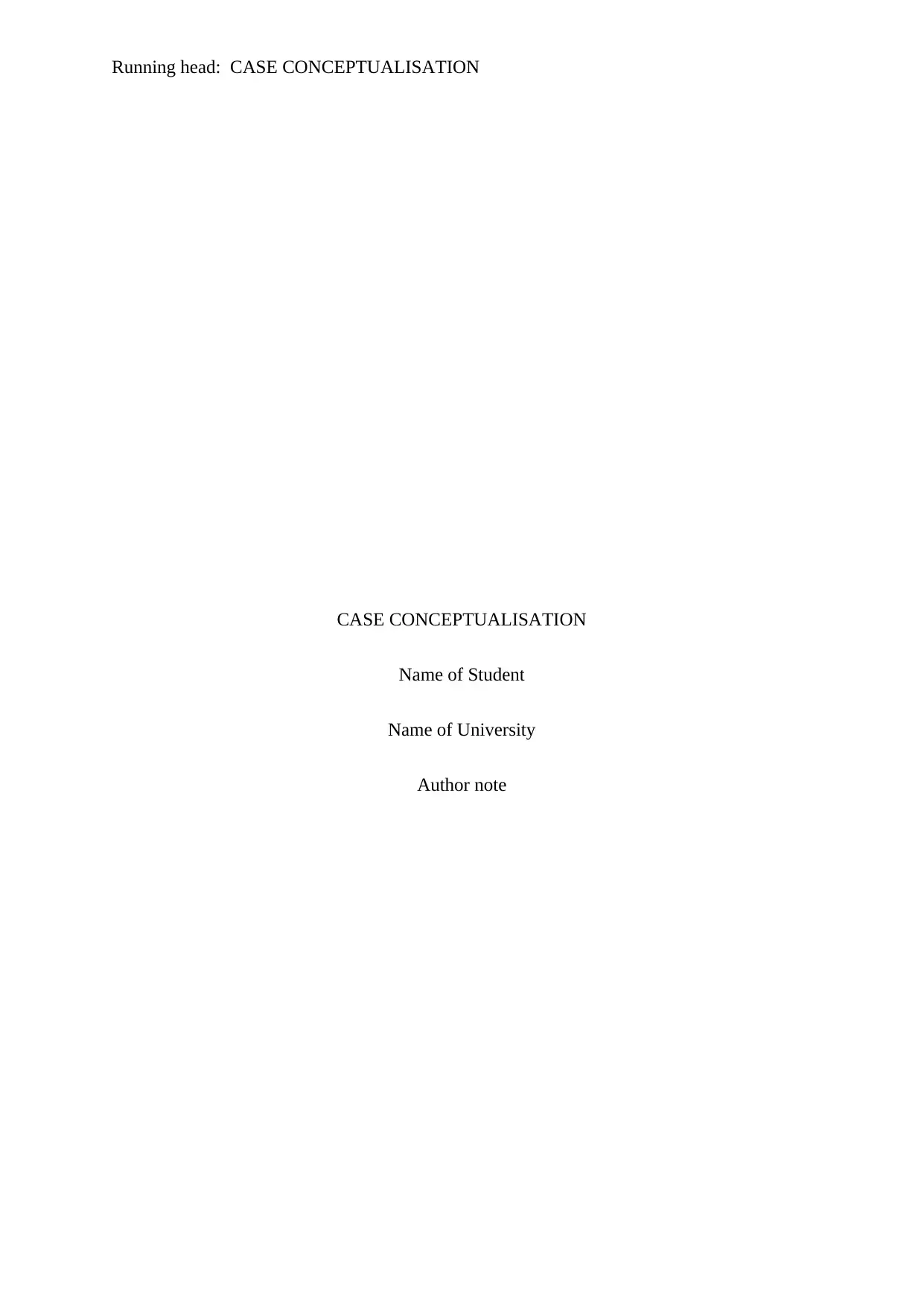
Running head: CASE CONCEPTUALISATION
CASE CONCEPTUALISATION
Name of Student
Name of University
Author note
CASE CONCEPTUALISATION
Name of Student
Name of University
Author note
Paraphrase This Document
Need a fresh take? Get an instant paraphrase of this document with our AI Paraphraser
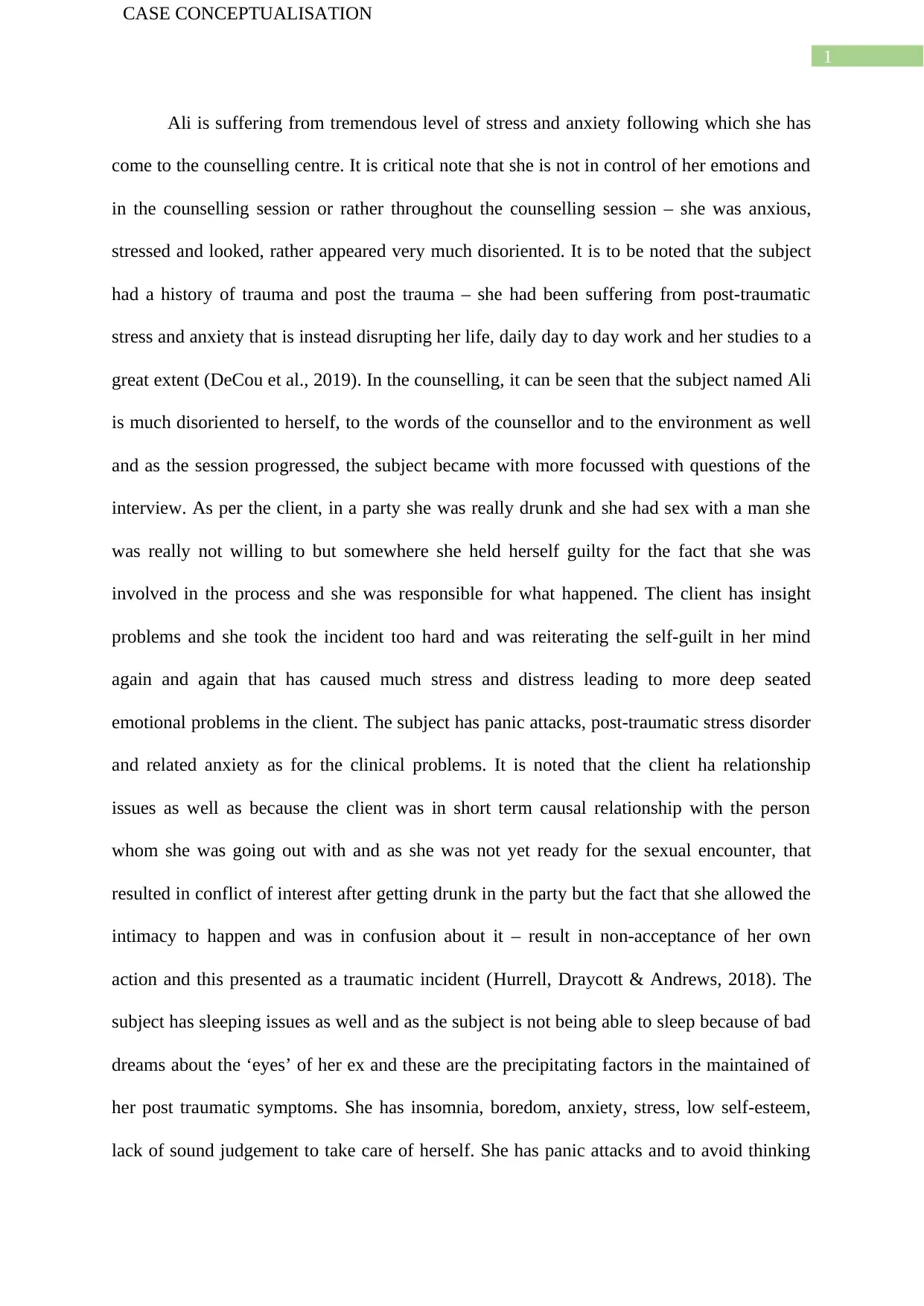
1
CASE CONCEPTUALISATION
Ali is suffering from tremendous level of stress and anxiety following which she has
come to the counselling centre. It is critical note that she is not in control of her emotions and
in the counselling session or rather throughout the counselling session – she was anxious,
stressed and looked, rather appeared very much disoriented. It is to be noted that the subject
had a history of trauma and post the trauma – she had been suffering from post-traumatic
stress and anxiety that is instead disrupting her life, daily day to day work and her studies to a
great extent (DeCou et al., 2019). In the counselling, it can be seen that the subject named Ali
is much disoriented to herself, to the words of the counsellor and to the environment as well
and as the session progressed, the subject became with more focussed with questions of the
interview. As per the client, in a party she was really drunk and she had sex with a man she
was really not willing to but somewhere she held herself guilty for the fact that she was
involved in the process and she was responsible for what happened. The client has insight
problems and she took the incident too hard and was reiterating the self-guilt in her mind
again and again that has caused much stress and distress leading to more deep seated
emotional problems in the client. The subject has panic attacks, post-traumatic stress disorder
and related anxiety as for the clinical problems. It is noted that the client ha relationship
issues as well as because the client was in short term causal relationship with the person
whom she was going out with and as she was not yet ready for the sexual encounter, that
resulted in conflict of interest after getting drunk in the party but the fact that she allowed the
intimacy to happen and was in confusion about it – result in non-acceptance of her own
action and this presented as a traumatic incident (Hurrell, Draycott & Andrews, 2018). The
subject has sleeping issues as well and as the subject is not being able to sleep because of bad
dreams about the ‘eyes’ of her ex and these are the precipitating factors in the maintained of
her post traumatic symptoms. She has insomnia, boredom, anxiety, stress, low self-esteem,
lack of sound judgement to take care of herself. She has panic attacks and to avoid thinking
CASE CONCEPTUALISATION
Ali is suffering from tremendous level of stress and anxiety following which she has
come to the counselling centre. It is critical note that she is not in control of her emotions and
in the counselling session or rather throughout the counselling session – she was anxious,
stressed and looked, rather appeared very much disoriented. It is to be noted that the subject
had a history of trauma and post the trauma – she had been suffering from post-traumatic
stress and anxiety that is instead disrupting her life, daily day to day work and her studies to a
great extent (DeCou et al., 2019). In the counselling, it can be seen that the subject named Ali
is much disoriented to herself, to the words of the counsellor and to the environment as well
and as the session progressed, the subject became with more focussed with questions of the
interview. As per the client, in a party she was really drunk and she had sex with a man she
was really not willing to but somewhere she held herself guilty for the fact that she was
involved in the process and she was responsible for what happened. The client has insight
problems and she took the incident too hard and was reiterating the self-guilt in her mind
again and again that has caused much stress and distress leading to more deep seated
emotional problems in the client. The subject has panic attacks, post-traumatic stress disorder
and related anxiety as for the clinical problems. It is noted that the client ha relationship
issues as well as because the client was in short term causal relationship with the person
whom she was going out with and as she was not yet ready for the sexual encounter, that
resulted in conflict of interest after getting drunk in the party but the fact that she allowed the
intimacy to happen and was in confusion about it – result in non-acceptance of her own
action and this presented as a traumatic incident (Hurrell, Draycott & Andrews, 2018). The
subject has sleeping issues as well and as the subject is not being able to sleep because of bad
dreams about the ‘eyes’ of her ex and these are the precipitating factors in the maintained of
her post traumatic symptoms. She has insomnia, boredom, anxiety, stress, low self-esteem,
lack of sound judgement to take care of herself. She has panic attacks and to avoid thinking
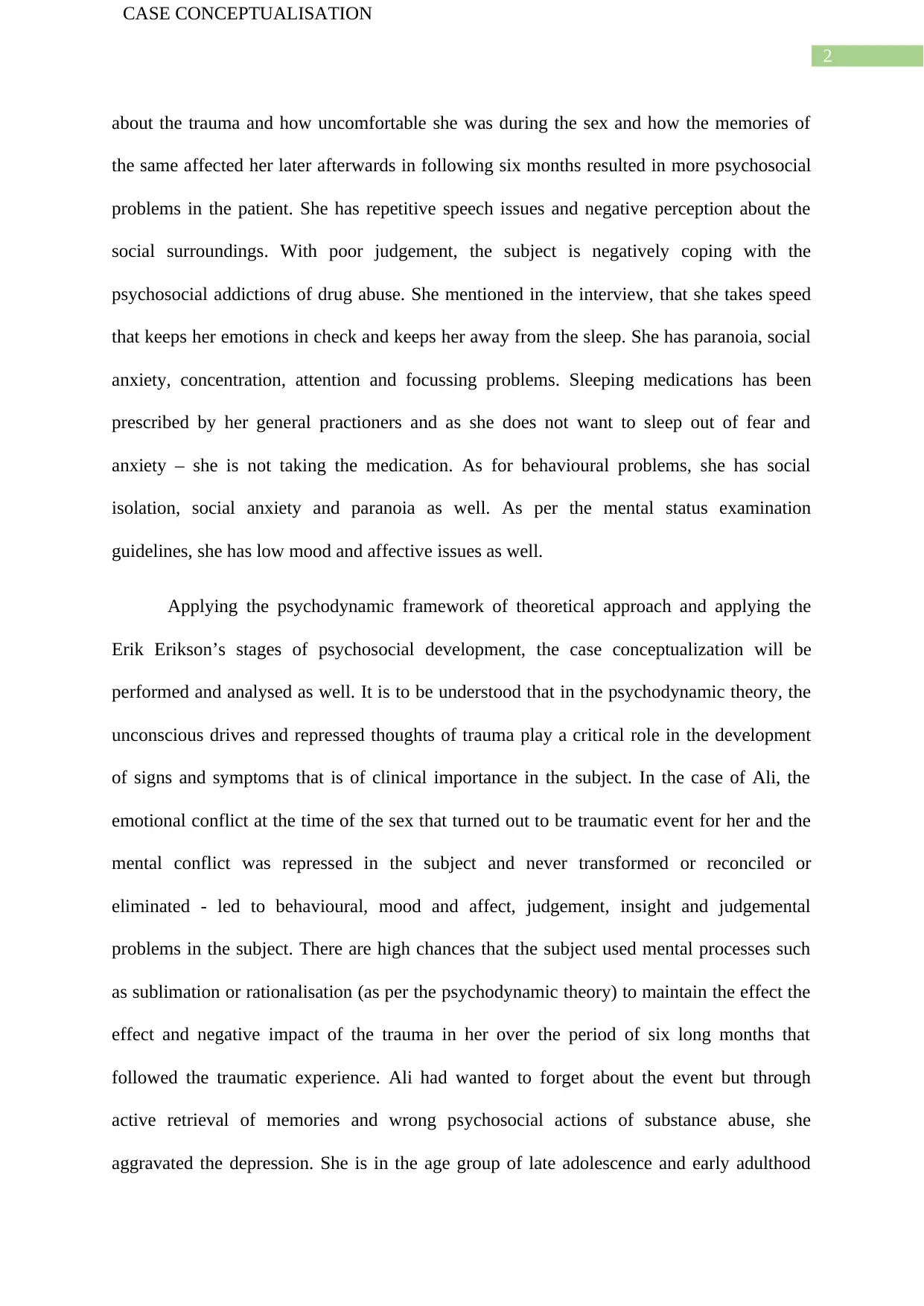
2
CASE CONCEPTUALISATION
about the trauma and how uncomfortable she was during the sex and how the memories of
the same affected her later afterwards in following six months resulted in more psychosocial
problems in the patient. She has repetitive speech issues and negative perception about the
social surroundings. With poor judgement, the subject is negatively coping with the
psychosocial addictions of drug abuse. She mentioned in the interview, that she takes speed
that keeps her emotions in check and keeps her away from the sleep. She has paranoia, social
anxiety, concentration, attention and focussing problems. Sleeping medications has been
prescribed by her general practioners and as she does not want to sleep out of fear and
anxiety – she is not taking the medication. As for behavioural problems, she has social
isolation, social anxiety and paranoia as well. As per the mental status examination
guidelines, she has low mood and affective issues as well.
Applying the psychodynamic framework of theoretical approach and applying the
Erik Erikson’s stages of psychosocial development, the case conceptualization will be
performed and analysed as well. It is to be understood that in the psychodynamic theory, the
unconscious drives and repressed thoughts of trauma play a critical role in the development
of signs and symptoms that is of clinical importance in the subject. In the case of Ali, the
emotional conflict at the time of the sex that turned out to be traumatic event for her and the
mental conflict was repressed in the subject and never transformed or reconciled or
eliminated - led to behavioural, mood and affect, judgement, insight and judgemental
problems in the subject. There are high chances that the subject used mental processes such
as sublimation or rationalisation (as per the psychodynamic theory) to maintain the effect the
effect and negative impact of the trauma in her over the period of six long months that
followed the traumatic experience. Ali had wanted to forget about the event but through
active retrieval of memories and wrong psychosocial actions of substance abuse, she
aggravated the depression. She is in the age group of late adolescence and early adulthood
CASE CONCEPTUALISATION
about the trauma and how uncomfortable she was during the sex and how the memories of
the same affected her later afterwards in following six months resulted in more psychosocial
problems in the patient. She has repetitive speech issues and negative perception about the
social surroundings. With poor judgement, the subject is negatively coping with the
psychosocial addictions of drug abuse. She mentioned in the interview, that she takes speed
that keeps her emotions in check and keeps her away from the sleep. She has paranoia, social
anxiety, concentration, attention and focussing problems. Sleeping medications has been
prescribed by her general practioners and as she does not want to sleep out of fear and
anxiety – she is not taking the medication. As for behavioural problems, she has social
isolation, social anxiety and paranoia as well. As per the mental status examination
guidelines, she has low mood and affective issues as well.
Applying the psychodynamic framework of theoretical approach and applying the
Erik Erikson’s stages of psychosocial development, the case conceptualization will be
performed and analysed as well. It is to be understood that in the psychodynamic theory, the
unconscious drives and repressed thoughts of trauma play a critical role in the development
of signs and symptoms that is of clinical importance in the subject. In the case of Ali, the
emotional conflict at the time of the sex that turned out to be traumatic event for her and the
mental conflict was repressed in the subject and never transformed or reconciled or
eliminated - led to behavioural, mood and affect, judgement, insight and judgemental
problems in the subject. There are high chances that the subject used mental processes such
as sublimation or rationalisation (as per the psychodynamic theory) to maintain the effect the
effect and negative impact of the trauma in her over the period of six long months that
followed the traumatic experience. Ali had wanted to forget about the event but through
active retrieval of memories and wrong psychosocial actions of substance abuse, she
aggravated the depression. She is in the age group of late adolescence and early adulthood
⊘ This is a preview!⊘
Do you want full access?
Subscribe today to unlock all pages.

Trusted by 1+ million students worldwide
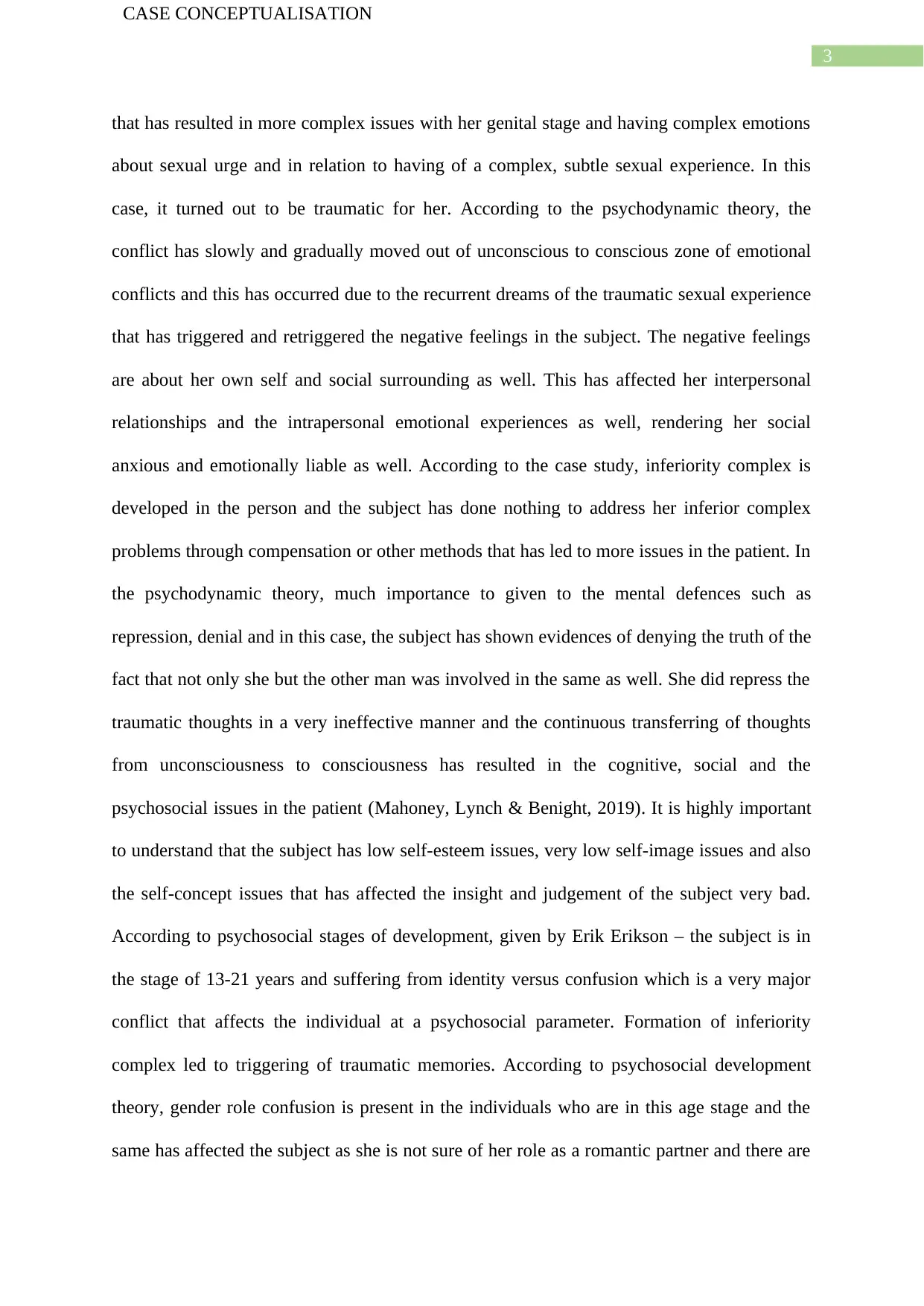
3
CASE CONCEPTUALISATION
that has resulted in more complex issues with her genital stage and having complex emotions
about sexual urge and in relation to having of a complex, subtle sexual experience. In this
case, it turned out to be traumatic for her. According to the psychodynamic theory, the
conflict has slowly and gradually moved out of unconscious to conscious zone of emotional
conflicts and this has occurred due to the recurrent dreams of the traumatic sexual experience
that has triggered and retriggered the negative feelings in the subject. The negative feelings
are about her own self and social surrounding as well. This has affected her interpersonal
relationships and the intrapersonal emotional experiences as well, rendering her social
anxious and emotionally liable as well. According to the case study, inferiority complex is
developed in the person and the subject has done nothing to address her inferior complex
problems through compensation or other methods that has led to more issues in the patient. In
the psychodynamic theory, much importance to given to the mental defences such as
repression, denial and in this case, the subject has shown evidences of denying the truth of the
fact that not only she but the other man was involved in the same as well. She did repress the
traumatic thoughts in a very ineffective manner and the continuous transferring of thoughts
from unconsciousness to consciousness has resulted in the cognitive, social and the
psychosocial issues in the patient (Mahoney, Lynch & Benight, 2019). It is highly important
to understand that the subject has low self-esteem issues, very low self-image issues and also
the self-concept issues that has affected the insight and judgement of the subject very bad.
According to psychosocial stages of development, given by Erik Erikson – the subject is in
the stage of 13-21 years and suffering from identity versus confusion which is a very major
conflict that affects the individual at a psychosocial parameter. Formation of inferiority
complex led to triggering of traumatic memories. According to psychosocial development
theory, gender role confusion is present in the individuals who are in this age stage and the
same has affected the subject as she is not sure of her role as a romantic partner and there are
CASE CONCEPTUALISATION
that has resulted in more complex issues with her genital stage and having complex emotions
about sexual urge and in relation to having of a complex, subtle sexual experience. In this
case, it turned out to be traumatic for her. According to the psychodynamic theory, the
conflict has slowly and gradually moved out of unconscious to conscious zone of emotional
conflicts and this has occurred due to the recurrent dreams of the traumatic sexual experience
that has triggered and retriggered the negative feelings in the subject. The negative feelings
are about her own self and social surrounding as well. This has affected her interpersonal
relationships and the intrapersonal emotional experiences as well, rendering her social
anxious and emotionally liable as well. According to the case study, inferiority complex is
developed in the person and the subject has done nothing to address her inferior complex
problems through compensation or other methods that has led to more issues in the patient. In
the psychodynamic theory, much importance to given to the mental defences such as
repression, denial and in this case, the subject has shown evidences of denying the truth of the
fact that not only she but the other man was involved in the same as well. She did repress the
traumatic thoughts in a very ineffective manner and the continuous transferring of thoughts
from unconsciousness to consciousness has resulted in the cognitive, social and the
psychosocial issues in the patient (Mahoney, Lynch & Benight, 2019). It is highly important
to understand that the subject has low self-esteem issues, very low self-image issues and also
the self-concept issues that has affected the insight and judgement of the subject very bad.
According to psychosocial stages of development, given by Erik Erikson – the subject is in
the stage of 13-21 years and suffering from identity versus confusion which is a very major
conflict that affects the individual at a psychosocial parameter. Formation of inferiority
complex led to triggering of traumatic memories. According to psychosocial development
theory, gender role confusion is present in the individuals who are in this age stage and the
same has affected the subject as she is not sure of her role as a romantic partner and there are
Paraphrase This Document
Need a fresh take? Get an instant paraphrase of this document with our AI Paraphraser
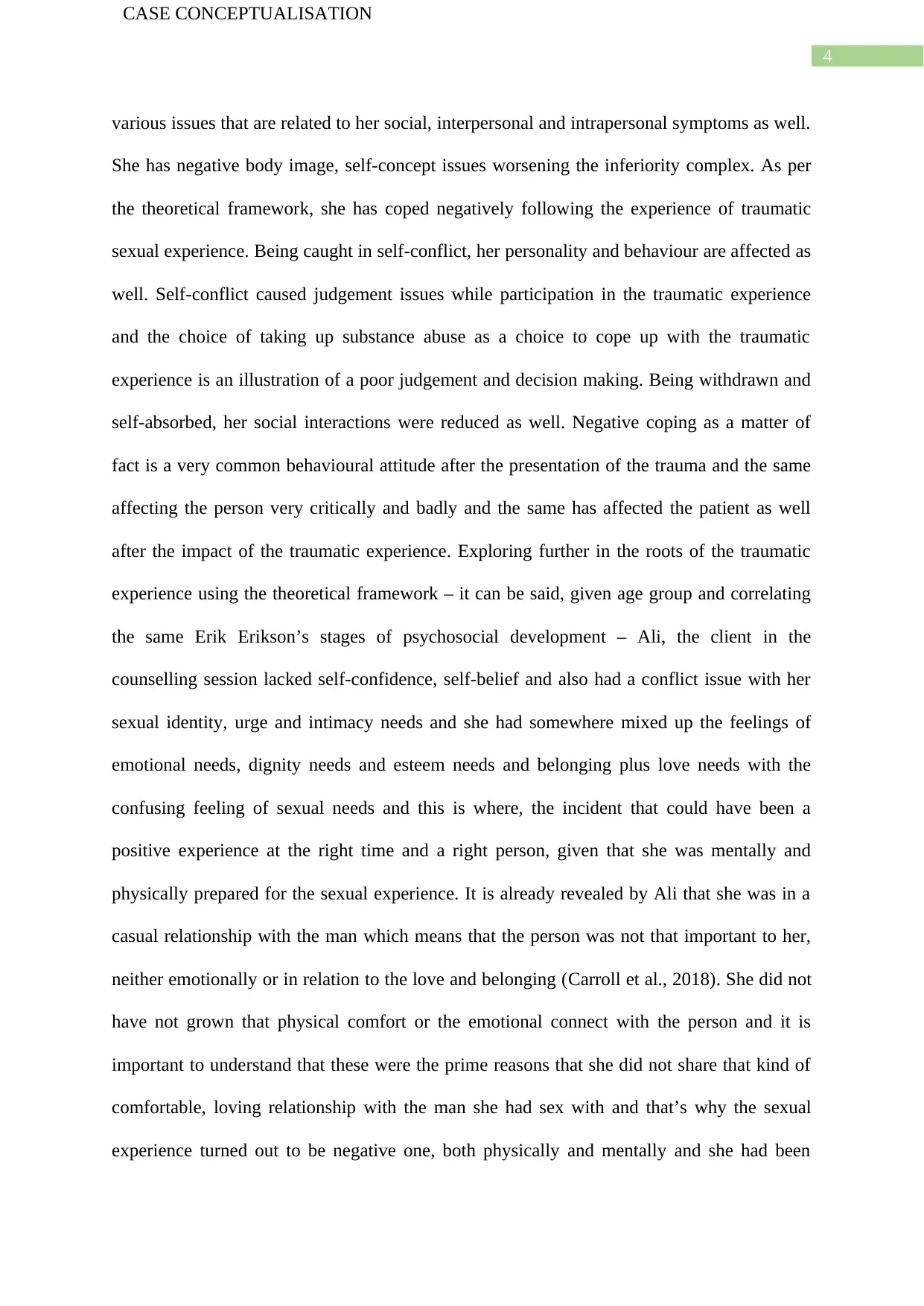
4
CASE CONCEPTUALISATION
various issues that are related to her social, interpersonal and intrapersonal symptoms as well.
She has negative body image, self-concept issues worsening the inferiority complex. As per
the theoretical framework, she has coped negatively following the experience of traumatic
sexual experience. Being caught in self-conflict, her personality and behaviour are affected as
well. Self-conflict caused judgement issues while participation in the traumatic experience
and the choice of taking up substance abuse as a choice to cope up with the traumatic
experience is an illustration of a poor judgement and decision making. Being withdrawn and
self-absorbed, her social interactions were reduced as well. Negative coping as a matter of
fact is a very common behavioural attitude after the presentation of the trauma and the same
affecting the person very critically and badly and the same has affected the patient as well
after the impact of the traumatic experience. Exploring further in the roots of the traumatic
experience using the theoretical framework – it can be said, given age group and correlating
the same Erik Erikson’s stages of psychosocial development – Ali, the client in the
counselling session lacked self-confidence, self-belief and also had a conflict issue with her
sexual identity, urge and intimacy needs and she had somewhere mixed up the feelings of
emotional needs, dignity needs and esteem needs and belonging plus love needs with the
confusing feeling of sexual needs and this is where, the incident that could have been a
positive experience at the right time and a right person, given that she was mentally and
physically prepared for the sexual experience. It is already revealed by Ali that she was in a
casual relationship with the man which means that the person was not that important to her,
neither emotionally or in relation to the love and belonging (Carroll et al., 2018). She did not
have not grown that physical comfort or the emotional connect with the person and it is
important to understand that these were the prime reasons that she did not share that kind of
comfortable, loving relationship with the man she had sex with and that’s why the sexual
experience turned out to be negative one, both physically and mentally and she had been
CASE CONCEPTUALISATION
various issues that are related to her social, interpersonal and intrapersonal symptoms as well.
She has negative body image, self-concept issues worsening the inferiority complex. As per
the theoretical framework, she has coped negatively following the experience of traumatic
sexual experience. Being caught in self-conflict, her personality and behaviour are affected as
well. Self-conflict caused judgement issues while participation in the traumatic experience
and the choice of taking up substance abuse as a choice to cope up with the traumatic
experience is an illustration of a poor judgement and decision making. Being withdrawn and
self-absorbed, her social interactions were reduced as well. Negative coping as a matter of
fact is a very common behavioural attitude after the presentation of the trauma and the same
affecting the person very critically and badly and the same has affected the patient as well
after the impact of the traumatic experience. Exploring further in the roots of the traumatic
experience using the theoretical framework – it can be said, given age group and correlating
the same Erik Erikson’s stages of psychosocial development – Ali, the client in the
counselling session lacked self-confidence, self-belief and also had a conflict issue with her
sexual identity, urge and intimacy needs and she had somewhere mixed up the feelings of
emotional needs, dignity needs and esteem needs and belonging plus love needs with the
confusing feeling of sexual needs and this is where, the incident that could have been a
positive experience at the right time and a right person, given that she was mentally and
physically prepared for the sexual experience. It is already revealed by Ali that she was in a
casual relationship with the man which means that the person was not that important to her,
neither emotionally or in relation to the love and belonging (Carroll et al., 2018). She did not
have not grown that physical comfort or the emotional connect with the person and it is
important to understand that these were the prime reasons that she did not share that kind of
comfortable, loving relationship with the man she had sex with and that’s why the sexual
experience turned out to be negative one, both physically and mentally and she had been
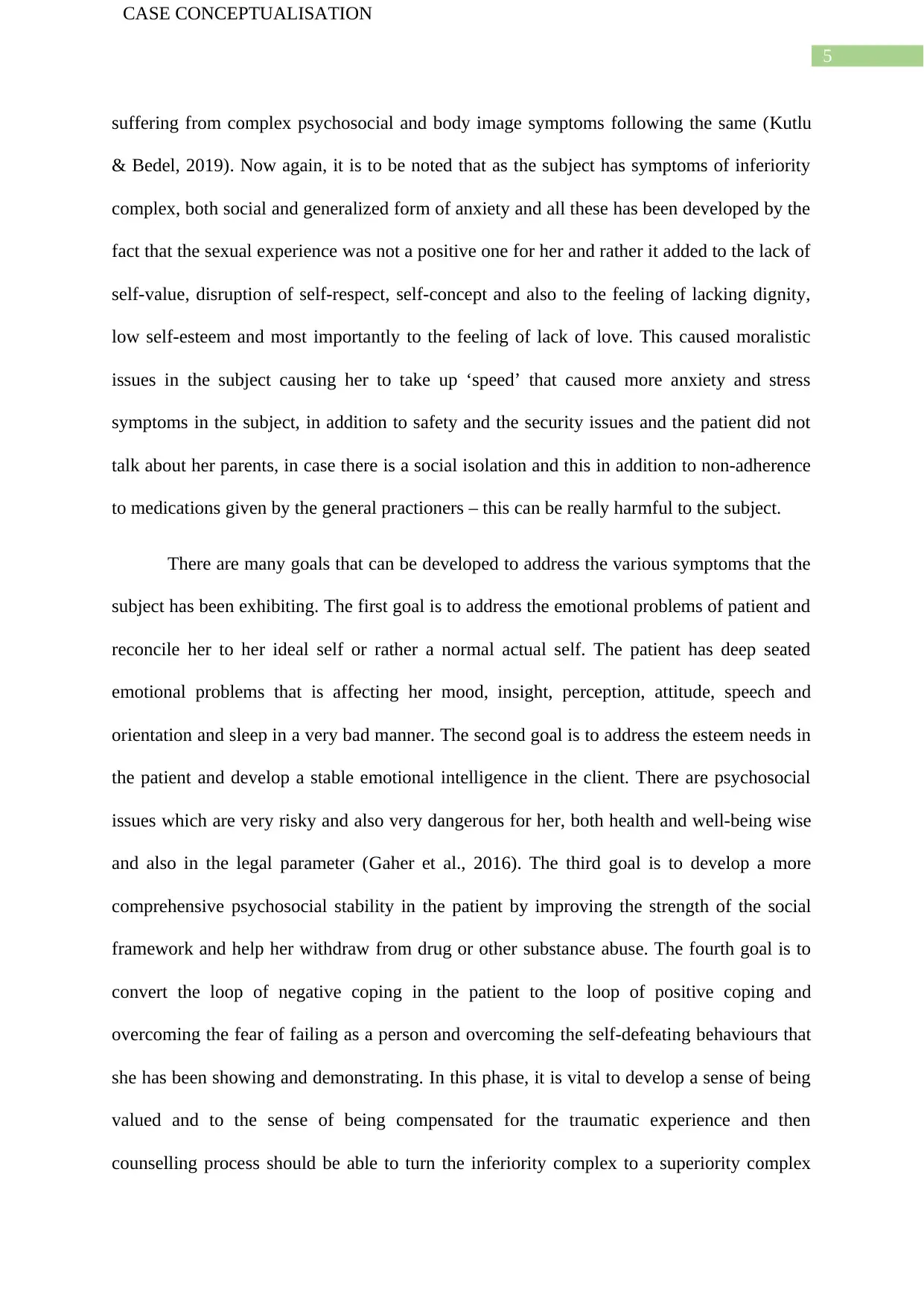
5
CASE CONCEPTUALISATION
suffering from complex psychosocial and body image symptoms following the same (Kutlu
& Bedel, 2019). Now again, it is to be noted that as the subject has symptoms of inferiority
complex, both social and generalized form of anxiety and all these has been developed by the
fact that the sexual experience was not a positive one for her and rather it added to the lack of
self-value, disruption of self-respect, self-concept and also to the feeling of lacking dignity,
low self-esteem and most importantly to the feeling of lack of love. This caused moralistic
issues in the subject causing her to take up ‘speed’ that caused more anxiety and stress
symptoms in the subject, in addition to safety and the security issues and the patient did not
talk about her parents, in case there is a social isolation and this in addition to non-adherence
to medications given by the general practioners – this can be really harmful to the subject.
There are many goals that can be developed to address the various symptoms that the
subject has been exhibiting. The first goal is to address the emotional problems of patient and
reconcile her to her ideal self or rather a normal actual self. The patient has deep seated
emotional problems that is affecting her mood, insight, perception, attitude, speech and
orientation and sleep in a very bad manner. The second goal is to address the esteem needs in
the patient and develop a stable emotional intelligence in the client. There are psychosocial
issues which are very risky and also very dangerous for her, both health and well-being wise
and also in the legal parameter (Gaher et al., 2016). The third goal is to develop a more
comprehensive psychosocial stability in the patient by improving the strength of the social
framework and help her withdraw from drug or other substance abuse. The fourth goal is to
convert the loop of negative coping in the patient to the loop of positive coping and
overcoming the fear of failing as a person and overcoming the self-defeating behaviours that
she has been showing and demonstrating. In this phase, it is vital to develop a sense of being
valued and to the sense of being compensated for the traumatic experience and then
counselling process should be able to turn the inferiority complex to a superiority complex
CASE CONCEPTUALISATION
suffering from complex psychosocial and body image symptoms following the same (Kutlu
& Bedel, 2019). Now again, it is to be noted that as the subject has symptoms of inferiority
complex, both social and generalized form of anxiety and all these has been developed by the
fact that the sexual experience was not a positive one for her and rather it added to the lack of
self-value, disruption of self-respect, self-concept and also to the feeling of lacking dignity,
low self-esteem and most importantly to the feeling of lack of love. This caused moralistic
issues in the subject causing her to take up ‘speed’ that caused more anxiety and stress
symptoms in the subject, in addition to safety and the security issues and the patient did not
talk about her parents, in case there is a social isolation and this in addition to non-adherence
to medications given by the general practioners – this can be really harmful to the subject.
There are many goals that can be developed to address the various symptoms that the
subject has been exhibiting. The first goal is to address the emotional problems of patient and
reconcile her to her ideal self or rather a normal actual self. The patient has deep seated
emotional problems that is affecting her mood, insight, perception, attitude, speech and
orientation and sleep in a very bad manner. The second goal is to address the esteem needs in
the patient and develop a stable emotional intelligence in the client. There are psychosocial
issues which are very risky and also very dangerous for her, both health and well-being wise
and also in the legal parameter (Gaher et al., 2016). The third goal is to develop a more
comprehensive psychosocial stability in the patient by improving the strength of the social
framework and help her withdraw from drug or other substance abuse. The fourth goal is to
convert the loop of negative coping in the patient to the loop of positive coping and
overcoming the fear of failing as a person and overcoming the self-defeating behaviours that
she has been showing and demonstrating. In this phase, it is vital to develop a sense of being
valued and to the sense of being compensated for the traumatic experience and then
counselling process should be able to turn the inferiority complex to a superiority complex
⊘ This is a preview!⊘
Do you want full access?
Subscribe today to unlock all pages.

Trusted by 1+ million students worldwide
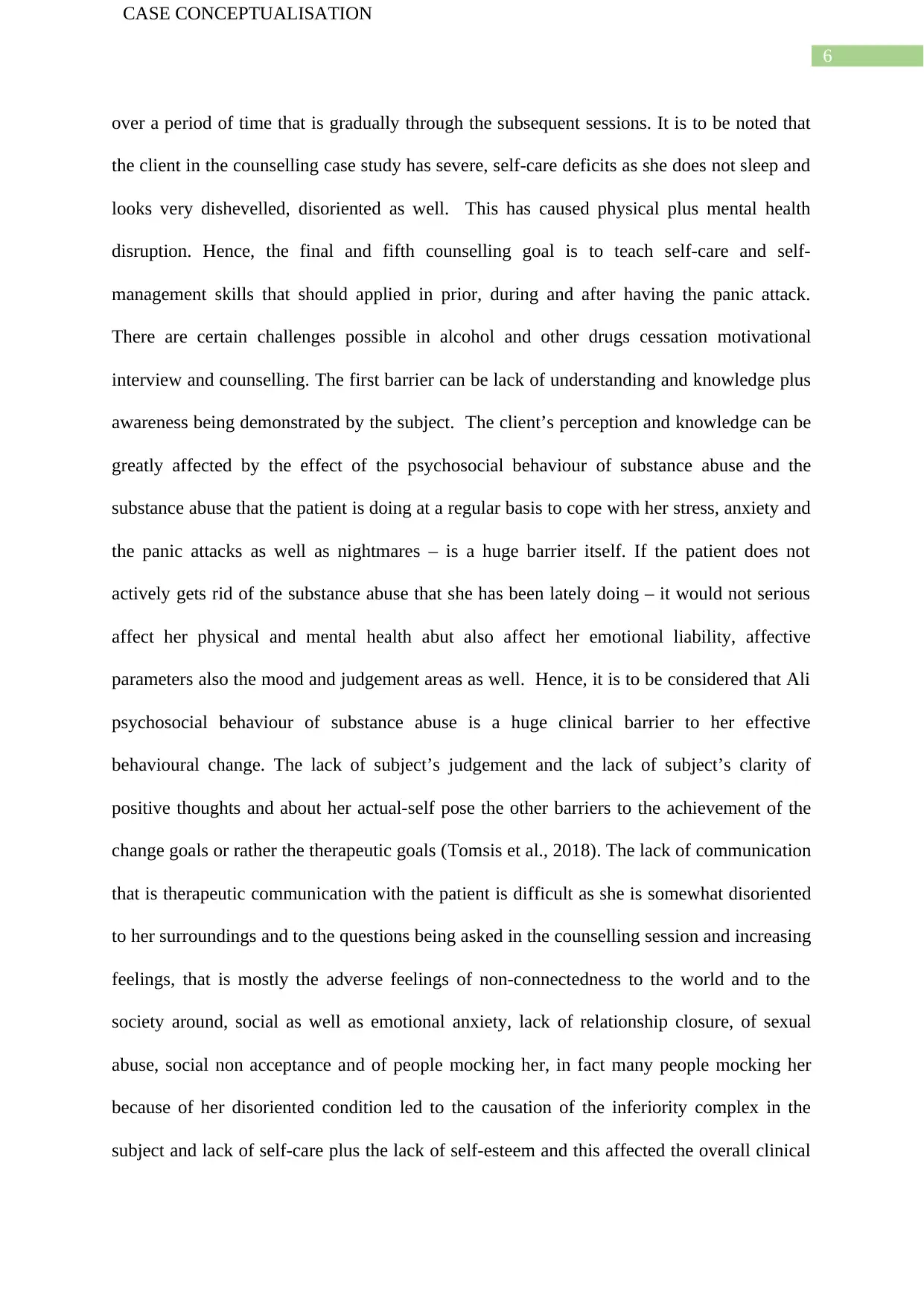
6
CASE CONCEPTUALISATION
over a period of time that is gradually through the subsequent sessions. It is to be noted that
the client in the counselling case study has severe, self-care deficits as she does not sleep and
looks very dishevelled, disoriented as well. This has caused physical plus mental health
disruption. Hence, the final and fifth counselling goal is to teach self-care and self-
management skills that should applied in prior, during and after having the panic attack.
There are certain challenges possible in alcohol and other drugs cessation motivational
interview and counselling. The first barrier can be lack of understanding and knowledge plus
awareness being demonstrated by the subject. The client’s perception and knowledge can be
greatly affected by the effect of the psychosocial behaviour of substance abuse and the
substance abuse that the patient is doing at a regular basis to cope with her stress, anxiety and
the panic attacks as well as nightmares – is a huge barrier itself. If the patient does not
actively gets rid of the substance abuse that she has been lately doing – it would not serious
affect her physical and mental health abut also affect her emotional liability, affective
parameters also the mood and judgement areas as well. Hence, it is to be considered that Ali
psychosocial behaviour of substance abuse is a huge clinical barrier to her effective
behavioural change. The lack of subject’s judgement and the lack of subject’s clarity of
positive thoughts and about her actual-self pose the other barriers to the achievement of the
change goals or rather the therapeutic goals (Tomsis et al., 2018). The lack of communication
that is therapeutic communication with the patient is difficult as she is somewhat disoriented
to her surroundings and to the questions being asked in the counselling session and increasing
feelings, that is mostly the adverse feelings of non-connectedness to the world and to the
society around, social as well as emotional anxiety, lack of relationship closure, of sexual
abuse, social non acceptance and of people mocking her, in fact many people mocking her
because of her disoriented condition led to the causation of the inferiority complex in the
subject and lack of self-care plus the lack of self-esteem and this affected the overall clinical
CASE CONCEPTUALISATION
over a period of time that is gradually through the subsequent sessions. It is to be noted that
the client in the counselling case study has severe, self-care deficits as she does not sleep and
looks very dishevelled, disoriented as well. This has caused physical plus mental health
disruption. Hence, the final and fifth counselling goal is to teach self-care and self-
management skills that should applied in prior, during and after having the panic attack.
There are certain challenges possible in alcohol and other drugs cessation motivational
interview and counselling. The first barrier can be lack of understanding and knowledge plus
awareness being demonstrated by the subject. The client’s perception and knowledge can be
greatly affected by the effect of the psychosocial behaviour of substance abuse and the
substance abuse that the patient is doing at a regular basis to cope with her stress, anxiety and
the panic attacks as well as nightmares – is a huge barrier itself. If the patient does not
actively gets rid of the substance abuse that she has been lately doing – it would not serious
affect her physical and mental health abut also affect her emotional liability, affective
parameters also the mood and judgement areas as well. Hence, it is to be considered that Ali
psychosocial behaviour of substance abuse is a huge clinical barrier to her effective
behavioural change. The lack of subject’s judgement and the lack of subject’s clarity of
positive thoughts and about her actual-self pose the other barriers to the achievement of the
change goals or rather the therapeutic goals (Tomsis et al., 2018). The lack of communication
that is therapeutic communication with the patient is difficult as she is somewhat disoriented
to her surroundings and to the questions being asked in the counselling session and increasing
feelings, that is mostly the adverse feelings of non-connectedness to the world and to the
society around, social as well as emotional anxiety, lack of relationship closure, of sexual
abuse, social non acceptance and of people mocking her, in fact many people mocking her
because of her disoriented condition led to the causation of the inferiority complex in the
subject and lack of self-care plus the lack of self-esteem and this affected the overall clinical
Paraphrase This Document
Need a fresh take? Get an instant paraphrase of this document with our AI Paraphraser
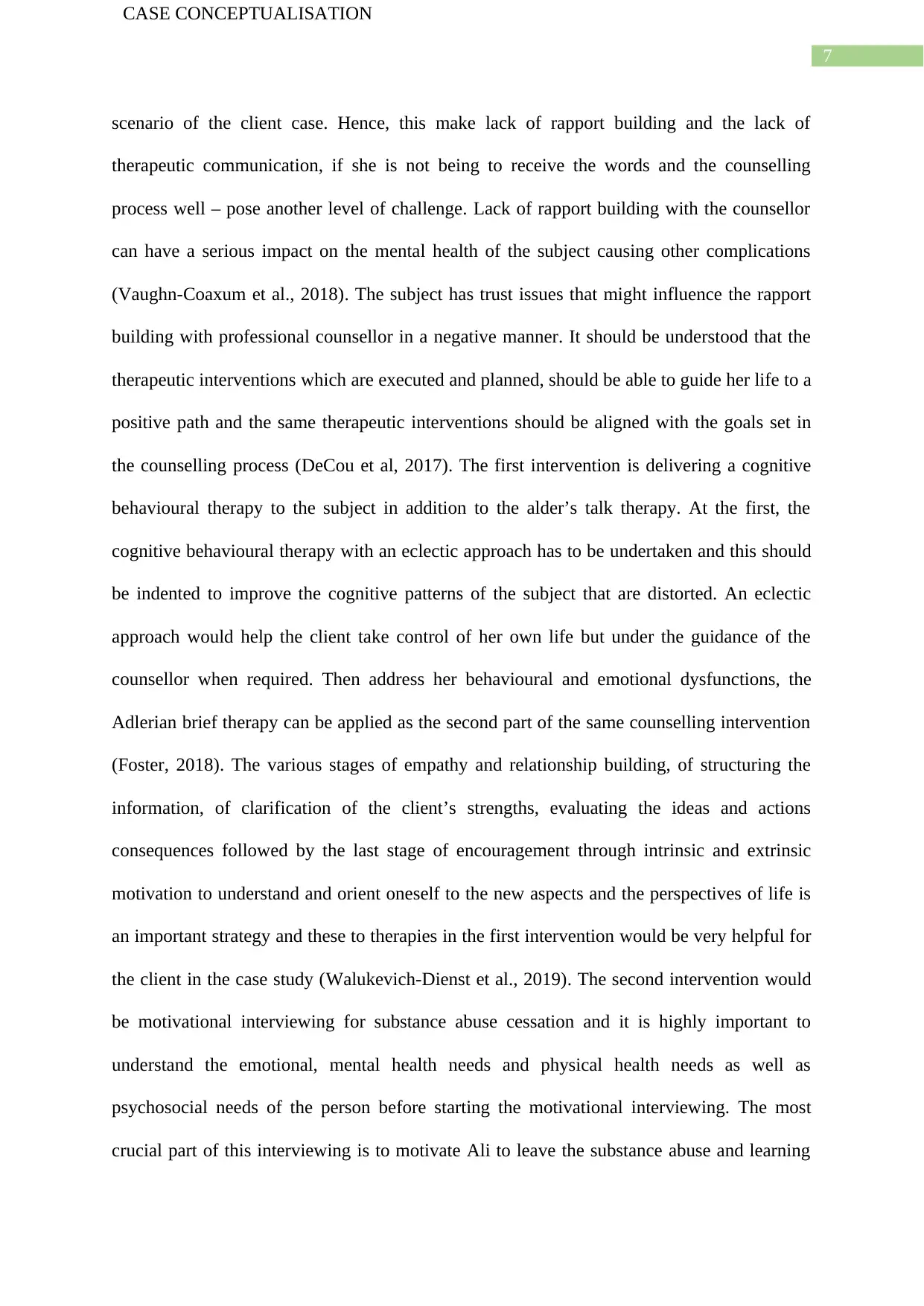
7
CASE CONCEPTUALISATION
scenario of the client case. Hence, this make lack of rapport building and the lack of
therapeutic communication, if she is not being to receive the words and the counselling
process well – pose another level of challenge. Lack of rapport building with the counsellor
can have a serious impact on the mental health of the subject causing other complications
(Vaughn-Coaxum et al., 2018). The subject has trust issues that might influence the rapport
building with professional counsellor in a negative manner. It should be understood that the
therapeutic interventions which are executed and planned, should be able to guide her life to a
positive path and the same therapeutic interventions should be aligned with the goals set in
the counselling process (DeCou et al, 2017). The first intervention is delivering a cognitive
behavioural therapy to the subject in addition to the alder’s talk therapy. At the first, the
cognitive behavioural therapy with an eclectic approach has to be undertaken and this should
be indented to improve the cognitive patterns of the subject that are distorted. An eclectic
approach would help the client take control of her own life but under the guidance of the
counsellor when required. Then address her behavioural and emotional dysfunctions, the
Adlerian brief therapy can be applied as the second part of the same counselling intervention
(Foster, 2018). The various stages of empathy and relationship building, of structuring the
information, of clarification of the client’s strengths, evaluating the ideas and actions
consequences followed by the last stage of encouragement through intrinsic and extrinsic
motivation to understand and orient oneself to the new aspects and the perspectives of life is
an important strategy and these to therapies in the first intervention would be very helpful for
the client in the case study (Walukevich-Dienst et al., 2019). The second intervention would
be motivational interviewing for substance abuse cessation and it is highly important to
understand the emotional, mental health needs and physical health needs as well as
psychosocial needs of the person before starting the motivational interviewing. The most
crucial part of this interviewing is to motivate Ali to leave the substance abuse and learning
CASE CONCEPTUALISATION
scenario of the client case. Hence, this make lack of rapport building and the lack of
therapeutic communication, if she is not being to receive the words and the counselling
process well – pose another level of challenge. Lack of rapport building with the counsellor
can have a serious impact on the mental health of the subject causing other complications
(Vaughn-Coaxum et al., 2018). The subject has trust issues that might influence the rapport
building with professional counsellor in a negative manner. It should be understood that the
therapeutic interventions which are executed and planned, should be able to guide her life to a
positive path and the same therapeutic interventions should be aligned with the goals set in
the counselling process (DeCou et al, 2017). The first intervention is delivering a cognitive
behavioural therapy to the subject in addition to the alder’s talk therapy. At the first, the
cognitive behavioural therapy with an eclectic approach has to be undertaken and this should
be indented to improve the cognitive patterns of the subject that are distorted. An eclectic
approach would help the client take control of her own life but under the guidance of the
counsellor when required. Then address her behavioural and emotional dysfunctions, the
Adlerian brief therapy can be applied as the second part of the same counselling intervention
(Foster, 2018). The various stages of empathy and relationship building, of structuring the
information, of clarification of the client’s strengths, evaluating the ideas and actions
consequences followed by the last stage of encouragement through intrinsic and extrinsic
motivation to understand and orient oneself to the new aspects and the perspectives of life is
an important strategy and these to therapies in the first intervention would be very helpful for
the client in the case study (Walukevich-Dienst et al., 2019). The second intervention would
be motivational interviewing for substance abuse cessation and it is highly important to
understand the emotional, mental health needs and physical health needs as well as
psychosocial needs of the person before starting the motivational interviewing. The most
crucial part of this interviewing is to motivate Ali to leave the substance abuse and learning
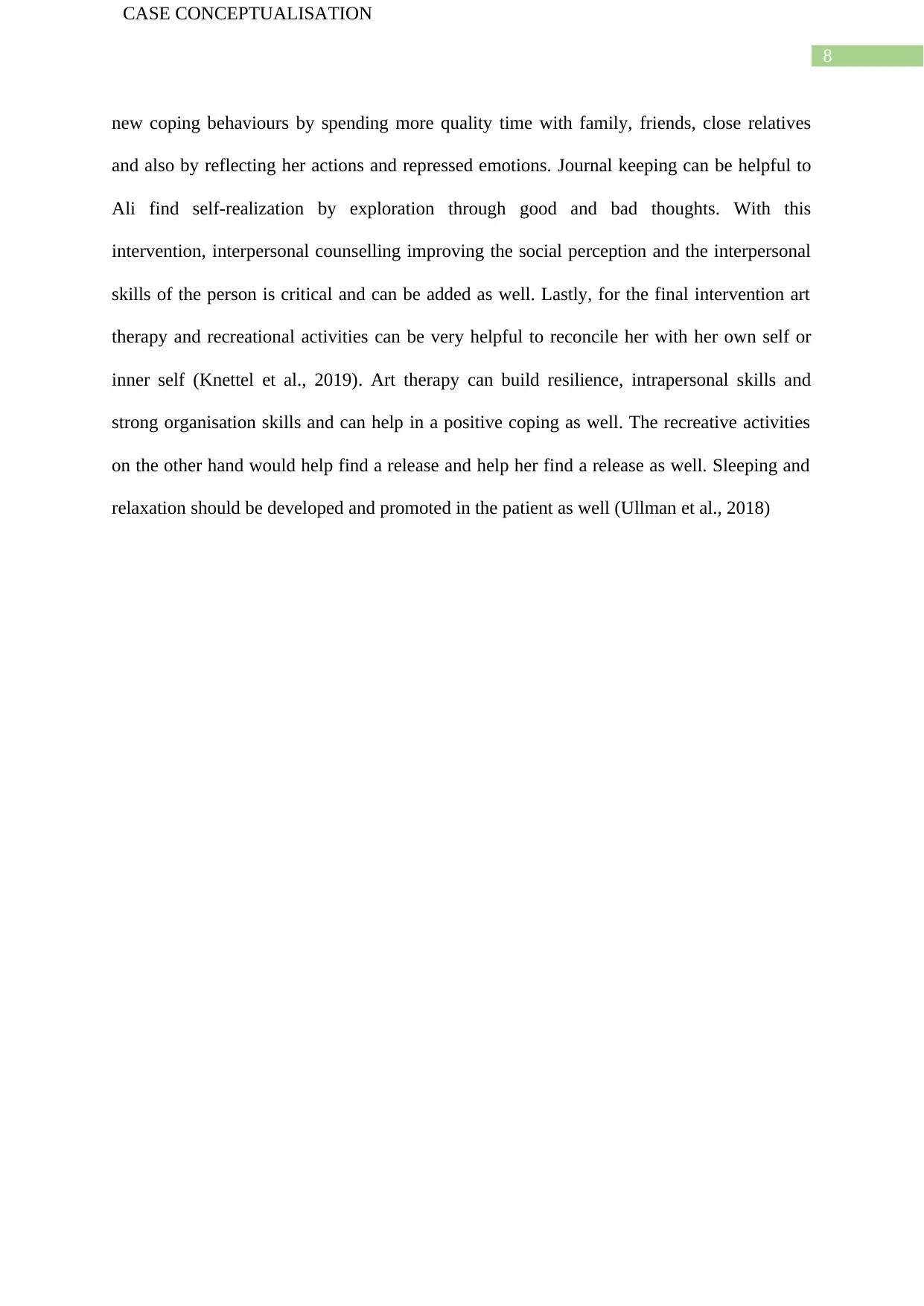
8
CASE CONCEPTUALISATION
new coping behaviours by spending more quality time with family, friends, close relatives
and also by reflecting her actions and repressed emotions. Journal keeping can be helpful to
Ali find self-realization by exploration through good and bad thoughts. With this
intervention, interpersonal counselling improving the social perception and the interpersonal
skills of the person is critical and can be added as well. Lastly, for the final intervention art
therapy and recreational activities can be very helpful to reconcile her with her own self or
inner self (Knettel et al., 2019). Art therapy can build resilience, intrapersonal skills and
strong organisation skills and can help in a positive coping as well. The recreative activities
on the other hand would help find a release and help her find a release as well. Sleeping and
relaxation should be developed and promoted in the patient as well (Ullman et al., 2018)
CASE CONCEPTUALISATION
new coping behaviours by spending more quality time with family, friends, close relatives
and also by reflecting her actions and repressed emotions. Journal keeping can be helpful to
Ali find self-realization by exploration through good and bad thoughts. With this
intervention, interpersonal counselling improving the social perception and the interpersonal
skills of the person is critical and can be added as well. Lastly, for the final intervention art
therapy and recreational activities can be very helpful to reconcile her with her own self or
inner self (Knettel et al., 2019). Art therapy can build resilience, intrapersonal skills and
strong organisation skills and can help in a positive coping as well. The recreative activities
on the other hand would help find a release and help her find a release as well. Sleeping and
relaxation should be developed and promoted in the patient as well (Ullman et al., 2018)
⊘ This is a preview!⊘
Do you want full access?
Subscribe today to unlock all pages.

Trusted by 1+ million students worldwide
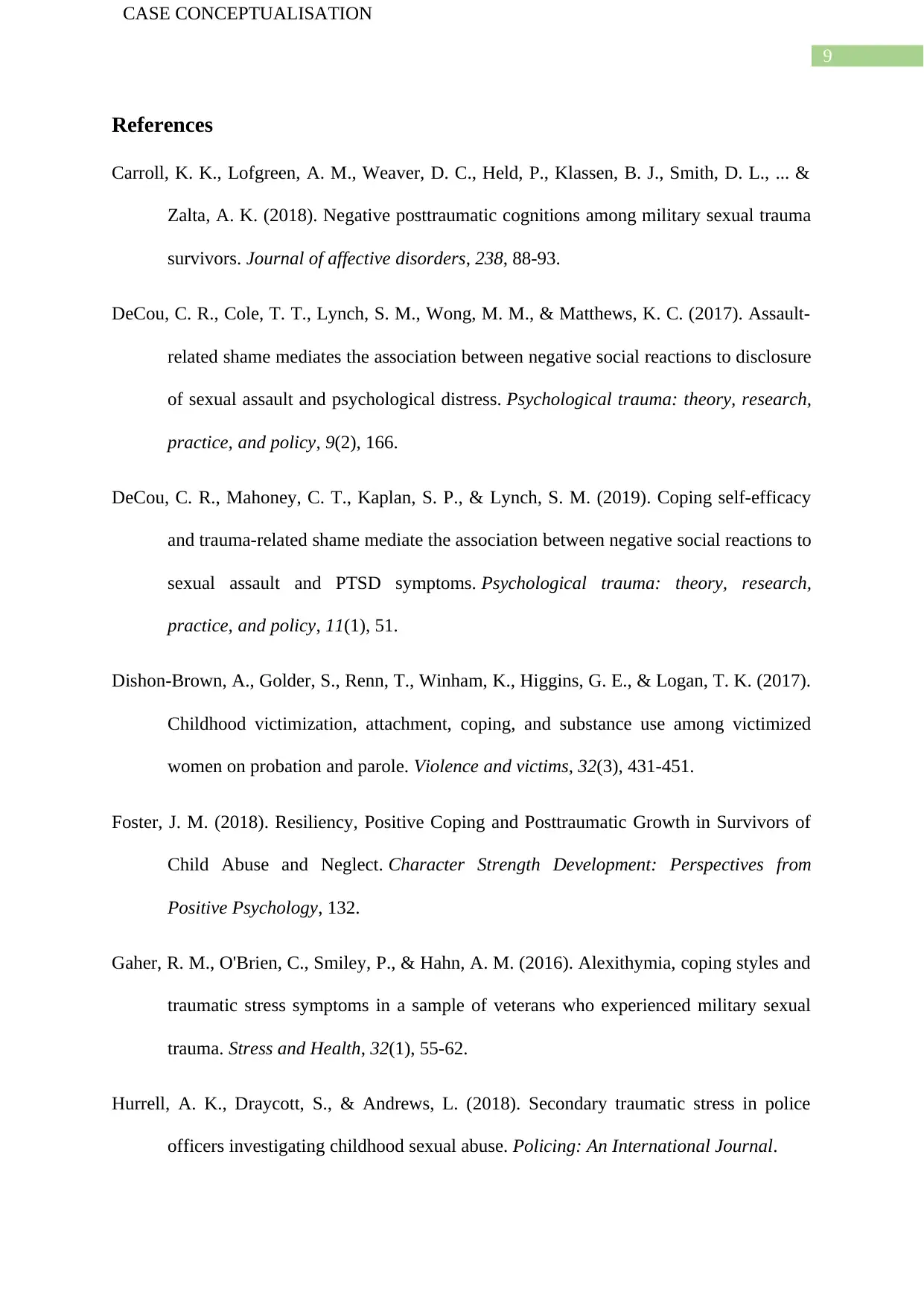
9
CASE CONCEPTUALISATION
References
Carroll, K. K., Lofgreen, A. M., Weaver, D. C., Held, P., Klassen, B. J., Smith, D. L., ... &
Zalta, A. K. (2018). Negative posttraumatic cognitions among military sexual trauma
survivors. Journal of affective disorders, 238, 88-93.
DeCou, C. R., Cole, T. T., Lynch, S. M., Wong, M. M., & Matthews, K. C. (2017). Assault-
related shame mediates the association between negative social reactions to disclosure
of sexual assault and psychological distress. Psychological trauma: theory, research,
practice, and policy, 9(2), 166.
DeCou, C. R., Mahoney, C. T., Kaplan, S. P., & Lynch, S. M. (2019). Coping self-efficacy
and trauma-related shame mediate the association between negative social reactions to
sexual assault and PTSD symptoms. Psychological trauma: theory, research,
practice, and policy, 11(1), 51.
Dishon-Brown, A., Golder, S., Renn, T., Winham, K., Higgins, G. E., & Logan, T. K. (2017).
Childhood victimization, attachment, coping, and substance use among victimized
women on probation and parole. Violence and victims, 32(3), 431-451.
Foster, J. M. (2018). Resiliency, Positive Coping and Posttraumatic Growth in Survivors of
Child Abuse and Neglect. Character Strength Development: Perspectives from
Positive Psychology, 132.
Gaher, R. M., O'Brien, C., Smiley, P., & Hahn, A. M. (2016). Alexithymia, coping styles and
traumatic stress symptoms in a sample of veterans who experienced military sexual
trauma. Stress and Health, 32(1), 55-62.
Hurrell, A. K., Draycott, S., & Andrews, L. (2018). Secondary traumatic stress in police
officers investigating childhood sexual abuse. Policing: An International Journal.
CASE CONCEPTUALISATION
References
Carroll, K. K., Lofgreen, A. M., Weaver, D. C., Held, P., Klassen, B. J., Smith, D. L., ... &
Zalta, A. K. (2018). Negative posttraumatic cognitions among military sexual trauma
survivors. Journal of affective disorders, 238, 88-93.
DeCou, C. R., Cole, T. T., Lynch, S. M., Wong, M. M., & Matthews, K. C. (2017). Assault-
related shame mediates the association between negative social reactions to disclosure
of sexual assault and psychological distress. Psychological trauma: theory, research,
practice, and policy, 9(2), 166.
DeCou, C. R., Mahoney, C. T., Kaplan, S. P., & Lynch, S. M. (2019). Coping self-efficacy
and trauma-related shame mediate the association between negative social reactions to
sexual assault and PTSD symptoms. Psychological trauma: theory, research,
practice, and policy, 11(1), 51.
Dishon-Brown, A., Golder, S., Renn, T., Winham, K., Higgins, G. E., & Logan, T. K. (2017).
Childhood victimization, attachment, coping, and substance use among victimized
women on probation and parole. Violence and victims, 32(3), 431-451.
Foster, J. M. (2018). Resiliency, Positive Coping and Posttraumatic Growth in Survivors of
Child Abuse and Neglect. Character Strength Development: Perspectives from
Positive Psychology, 132.
Gaher, R. M., O'Brien, C., Smiley, P., & Hahn, A. M. (2016). Alexithymia, coping styles and
traumatic stress symptoms in a sample of veterans who experienced military sexual
trauma. Stress and Health, 32(1), 55-62.
Hurrell, A. K., Draycott, S., & Andrews, L. (2018). Secondary traumatic stress in police
officers investigating childhood sexual abuse. Policing: An International Journal.
Paraphrase This Document
Need a fresh take? Get an instant paraphrase of this document with our AI Paraphraser
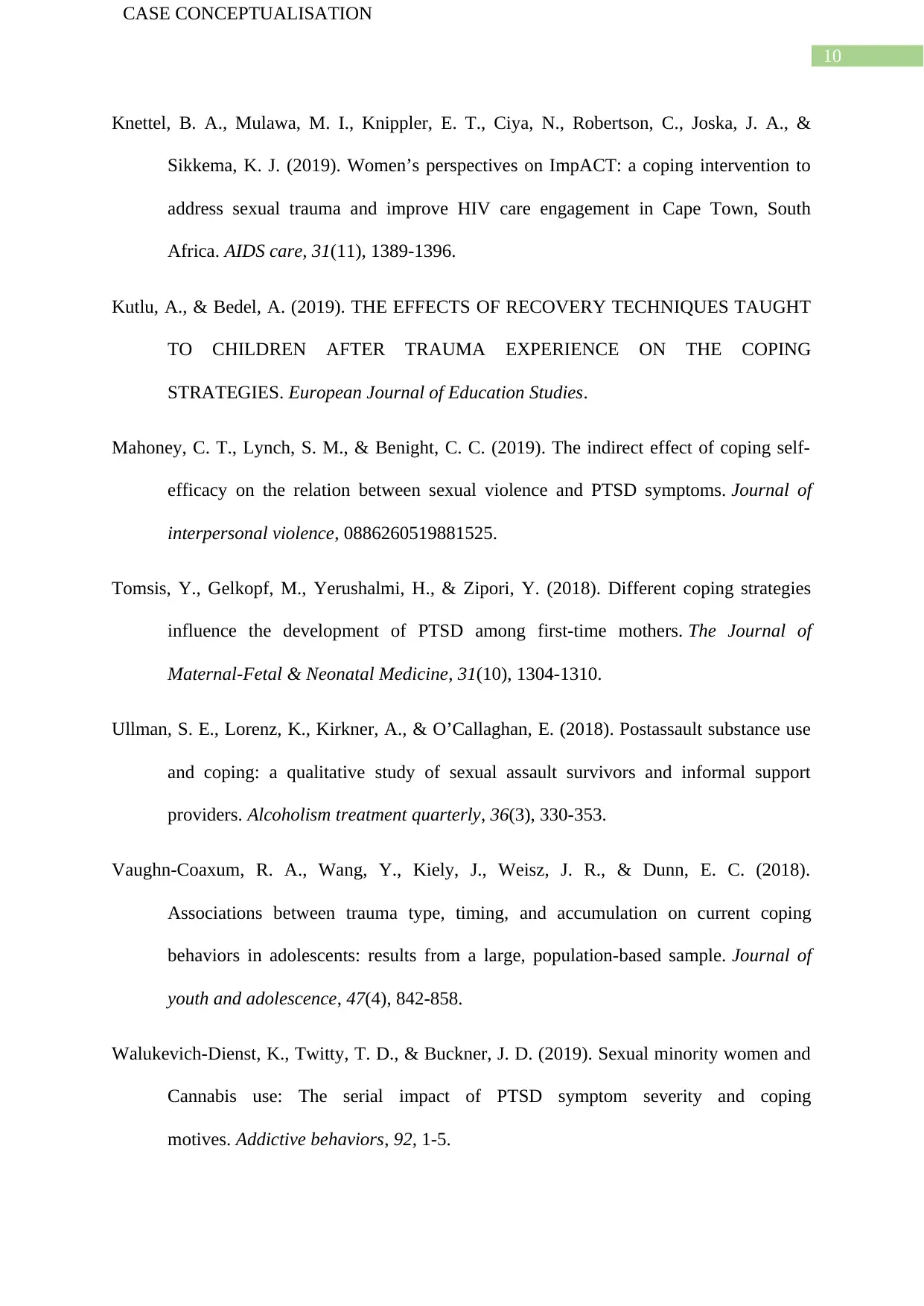
10
CASE CONCEPTUALISATION
Knettel, B. A., Mulawa, M. I., Knippler, E. T., Ciya, N., Robertson, C., Joska, J. A., &
Sikkema, K. J. (2019). Women’s perspectives on ImpACT: a coping intervention to
address sexual trauma and improve HIV care engagement in Cape Town, South
Africa. AIDS care, 31(11), 1389-1396.
Kutlu, A., & Bedel, A. (2019). THE EFFECTS OF RECOVERY TECHNIQUES TAUGHT
TO CHILDREN AFTER TRAUMA EXPERIENCE ON THE COPING
STRATEGIES. European Journal of Education Studies.
Mahoney, C. T., Lynch, S. M., & Benight, C. C. (2019). The indirect effect of coping self-
efficacy on the relation between sexual violence and PTSD symptoms. Journal of
interpersonal violence, 0886260519881525.
Tomsis, Y., Gelkopf, M., Yerushalmi, H., & Zipori, Y. (2018). Different coping strategies
influence the development of PTSD among first-time mothers. The Journal of
Maternal-Fetal & Neonatal Medicine, 31(10), 1304-1310.
Ullman, S. E., Lorenz, K., Kirkner, A., & O’Callaghan, E. (2018). Postassault substance use
and coping: a qualitative study of sexual assault survivors and informal support
providers. Alcoholism treatment quarterly, 36(3), 330-353.
Vaughn-Coaxum, R. A., Wang, Y., Kiely, J., Weisz, J. R., & Dunn, E. C. (2018).
Associations between trauma type, timing, and accumulation on current coping
behaviors in adolescents: results from a large, population-based sample. Journal of
youth and adolescence, 47(4), 842-858.
Walukevich-Dienst, K., Twitty, T. D., & Buckner, J. D. (2019). Sexual minority women and
Cannabis use: The serial impact of PTSD symptom severity and coping
motives. Addictive behaviors, 92, 1-5.
CASE CONCEPTUALISATION
Knettel, B. A., Mulawa, M. I., Knippler, E. T., Ciya, N., Robertson, C., Joska, J. A., &
Sikkema, K. J. (2019). Women’s perspectives on ImpACT: a coping intervention to
address sexual trauma and improve HIV care engagement in Cape Town, South
Africa. AIDS care, 31(11), 1389-1396.
Kutlu, A., & Bedel, A. (2019). THE EFFECTS OF RECOVERY TECHNIQUES TAUGHT
TO CHILDREN AFTER TRAUMA EXPERIENCE ON THE COPING
STRATEGIES. European Journal of Education Studies.
Mahoney, C. T., Lynch, S. M., & Benight, C. C. (2019). The indirect effect of coping self-
efficacy on the relation between sexual violence and PTSD symptoms. Journal of
interpersonal violence, 0886260519881525.
Tomsis, Y., Gelkopf, M., Yerushalmi, H., & Zipori, Y. (2018). Different coping strategies
influence the development of PTSD among first-time mothers. The Journal of
Maternal-Fetal & Neonatal Medicine, 31(10), 1304-1310.
Ullman, S. E., Lorenz, K., Kirkner, A., & O’Callaghan, E. (2018). Postassault substance use
and coping: a qualitative study of sexual assault survivors and informal support
providers. Alcoholism treatment quarterly, 36(3), 330-353.
Vaughn-Coaxum, R. A., Wang, Y., Kiely, J., Weisz, J. R., & Dunn, E. C. (2018).
Associations between trauma type, timing, and accumulation on current coping
behaviors in adolescents: results from a large, population-based sample. Journal of
youth and adolescence, 47(4), 842-858.
Walukevich-Dienst, K., Twitty, T. D., & Buckner, J. D. (2019). Sexual minority women and
Cannabis use: The serial impact of PTSD symptom severity and coping
motives. Addictive behaviors, 92, 1-5.

11
CASE CONCEPTUALISATION
CASE CONCEPTUALISATION
⊘ This is a preview!⊘
Do you want full access?
Subscribe today to unlock all pages.

Trusted by 1+ million students worldwide
1 out of 12
Your All-in-One AI-Powered Toolkit for Academic Success.
+13062052269
info@desklib.com
Available 24*7 on WhatsApp / Email
![[object Object]](/_next/static/media/star-bottom.7253800d.svg)
Unlock your academic potential
Copyright © 2020–2025 A2Z Services. All Rights Reserved. Developed and managed by ZUCOL.

